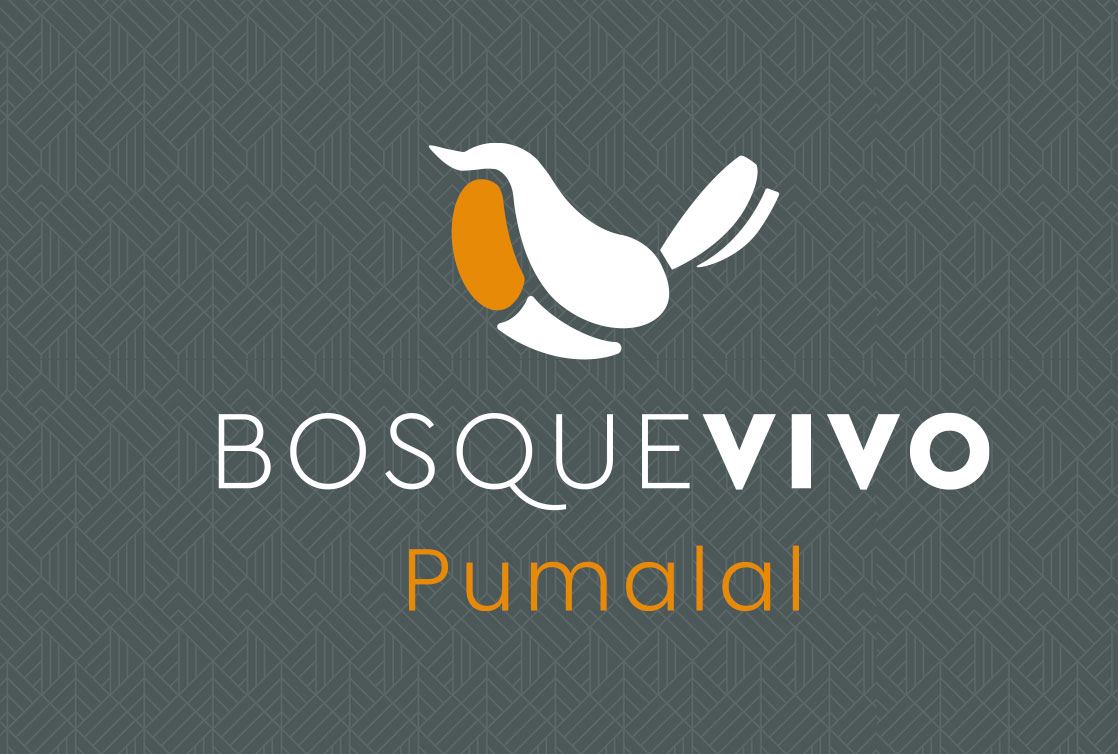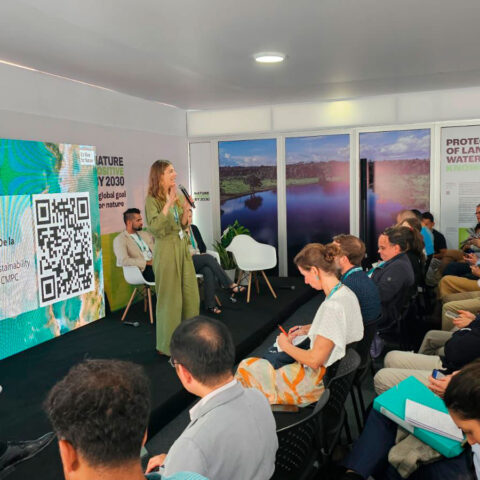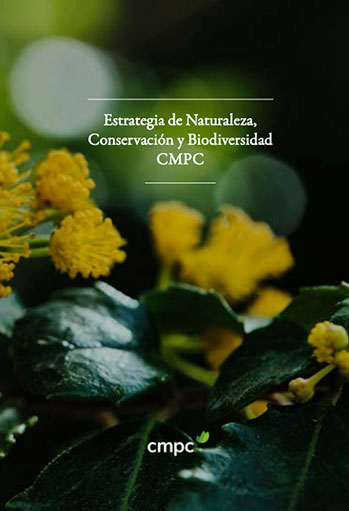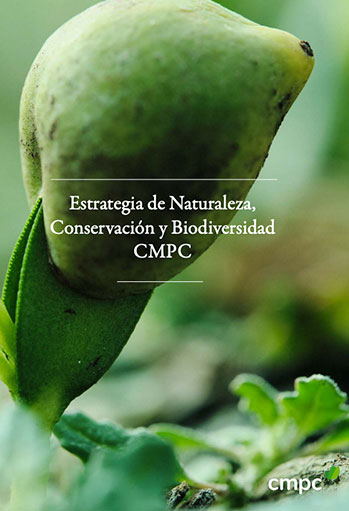ECOSYSTEMS AND BIODIVERSITY CONSERVATION
We are committed to conserving and protecting ecosystems and biodiversity, not deforestation, by maintaining hectares of native forest, protecting water courses, flora, and fauna, and restoring ecosystems. We understand the latter as the activity that initiates or accelerates the recovery of an ecosystem, improving the state of conservation, recovering degraded sites, and increasing the flow of ecosystem goods and services.
We are committed to conserving and protecting ecosystems and biodiversity, not deforestation, by maintaining hectares of native forest, protecting water courses, flora, and fauna, and restoring ecosystems. We understand the latter as the activity that initiates or accelerates the recovery of an ecosystem, improving the state of conservation, recovering degraded sites, and increasing the flow of ecosystem goods and services.
CMPC’s Nature, Conservation and Biodiversity Strategy is based on four pillars. The first is Biodiversity, which seeks to promote all life that exists on Earth; next is the Ecosystem services axis, which consists of identifying and highlighting the benefits that people obtain from ecosystems; thirdly, creating Nature-based Solutions, which refers to using natural elements to address socio-environmental challenges; and finally, Territoriality, which consists of having a complete view of the landscape, incorporating the vision of the communities, inside and outside of CMPC’s heritage.
CMPC’s Nature, Conservation and Biodiversity Strategy is based on four pillars. The first is Biodiversity, which seeks to promote all life that exists on Earth; next is the Ecosystem services axis, which consists of identifying and highlighting the benefits that people obtain from ecosystems; thirdly, creating Nature-based Solutions, which refers to using natural elements to address socio-environmental challenges; and finally, Territoriality, which consists of having a complete view of the landscape, incorporating the vision of the communities, inside and outside of CMPC’s heritage.
CONSERVATION, PROTECTION AND/OR RESTORATION PERFORMANCE GOAL
| 2018 Baseline | 2019 | 2020 | 2021 | 2022 | 2023 | Meta al 2030 | |
| Performance (ha) | 321,529 | 325,995 | 385,726 | 389,376 | 402,817 | 409,826 | 421,529 (100%) |
| Annual variation (ha) | - | 4,466 | 64,197 | 3,650 | 81,288 | 88,297 | 100,000 |
| Percentage of progress towards goal | - | 4.5% | 64.2% | 67.8% | 81.3% | 88.3% | 100% |
Biodiversity and Risk Management
CMPC considers biodiversity conservation a fundamental aspect of its sustainability strategy. The company is committed to protecting and enhancing biodiversity across its operations and supply chains. This approach is guided by comprehensive risk assessments and sustainable forest management practices.
Biodiversity Risk Management
CMPC has developed an integrated process to identify and evaluate biodiversity risks related to its impacts. This process is based on the company’s Nature Conservation and Biodiversity Strategy and utilizes the IUCN methodology aligned with the TNFD LEAP approach. The company’s risk analysis includes identifying pressures and assessing impacts, using specific biodiversity indicators to monitor changes. CMPC’s assessments are location-specific, ensuring precise identification of pressures and impacts in different operational contexts. Currently, CMPC’s Risk Management System includes risks related to “Damage to Protection Areas” and “Native Forest Logging,” and but the company is working to incorporate biodiversity pressure analysis into the system by 2024. This ensures all operational and investment decisions consider ecosystem services vital to its processes.
Comprehensive Risk Coverage and Identified Biodiversity Risks
CMPC’s biodiversity risk evaluations cover:
- Own operations
- Adjacent areas
- Upstream activities
- Downstream activities
CMPC has identified and manages biodiversity risks through:
- Conservation and Restoration Plans: Implementing specific plans to conserve high ecological value areas and restore degraded ecosystems, covering over 400,000 hectares, including native forests and high biodiversity areas in Chile, Brazil, and Argentina.
- Monitoring and Adaptation: Continuous monitoring of its activities impacts and adapting practices as needed to improve conservation strategies and minimize biodiversity risks.
CMPC considers biodiversity conservation a fundamental aspect of its sustainability strategy. The company is committed to protecting and enhancing biodiversity across its operations and supply chains. This approach is guided by comprehensive risk assessments and sustainable forest management practices.
Biodiversity Risk Management
CMPC has developed an integrated process to identify and evaluate biodiversity risks related to its impacts. This process is based on the company’s Nature Conservation and Biodiversity Strategy and utilizes the IUCN methodology aligned with the TNFD LEAP approach. The company’s risk analysis includes identifying pressures and assessing impacts, using specific biodiversity indicators to monitor changes. CMPC’s assessments are location-specific, ensuring precise identification of pressures and impacts in different operational contexts. Currently, CMPC’s Risk Management System includes risks related to “Damage to Protection Areas” and “Native Forest Logging,” and but the company is working to incorporate biodiversity pressure analysis into the system by 2024. This ensures all operational and investment decisions consider ecosystem services vital to its processes.
Comprehensive Risk Coverage and Identified Biodiversity Risks
CMPC’s biodiversity risk evaluations cover:
- Own operations
- Adjacent areas
- Upstream activities
- Downstream activities
CMPC has identified and manages biodiversity risks through:
- Conservation and Restoration Plans: Implementing specific plans to conserve high ecological value areas and restore degraded ecosystems, covering over 400,000 hectares, including native forests and high biodiversity areas in Chile, Brazil, and Argentina.
- Monitoring and Adaptation: Continuous monitoring of its activities impacts and adapting practices as needed to improve conservation strategies and minimize biodiversity risks.
CONTRIBUTION BY COUNTRY TO THE AREA UNDER CONSERVATION, PROTECTION, AND RESTORATION
| 2019 | 2020 | 2021 | 2022 | 2023 | |
| Total area (ha) | 325,995 | 385,726 | 389,376 | 402,817 | 409,826 |
| Argentina | 5.79% | 4.94% | 4.89% | 5.02% | 5.1% |
| Brasil | 42.82% | 51.19% | 51.15% | 52.15% | 52.4% |
| Chile | 51.39% | 43.87% | 43.96% | 42.83% | 42.5% |
In addition, through sustainable forest management certification in Chile, we have made a voluntary commitment to restoration by 2026 and 2028:
PROGRESS IN COMPLIANCE WITH THE VOLUNTARY RESTORATION COMMITMENTS (HA)
| Restored 2010-2018 | 2020 | 2021 | 2022 | 2023 | Progress | Commitment to | |
| South-Central | 1,890 | 430 | 613 | 709 | 883 | 56% | 8.738 (2026) |
| Coyhaique | 50 | - | - | - | 15 | 6% | 1,181 (2028) |
Quantity and area of AHCV:
| 2019 | 2020 | 2021 | 2022 | 2023 | ||||||
| N° | Ha | N° | Ha | N° | Ha | N° | Ha | N° | Ha | |
| Total | 439 | 28,499 | 447 | 28,501 | 481 | 28,192 | 476 | 28,257 | 468 | 27,980 |
| Biological (ha) | 26 | 24,482 | 26 | 24,482 | 30 | 24,711 | 33 | 24,785 | 34 | 24,963 |
| Servicio | 378 | 3,621 | 382 | 3,622 | 408 | 3,034 | 408 | 3,079 | 405 | 3,025 |
| Sociocultural (ha) | 35 | 396 | 39 | 397 | 43 | 447 | 35 | 393 | 29 | 224 |
NUMBER OF FIRE OUTBREAKS AND AREA AFFECTED BY FIRES IN CHILE, BRAZIL, AND ARGENTINA.
| 2019-2020 Season | 2020-2021 Season | 2021-2022 Season | 2022-2023 Season | |||||
| Outbreaks | Ha | Outbreaks | Ha | Outbreaks | Ha | Outbreaks | Ha | |
| Total | 1,605 | 4,261 | 1,129 | 6,575 | 1,268 | 11,039 | 1,324 | 38,619 |
CMPC'S MITIGATION STRATEGIES: COMPREHENSIVE ACTIONS TO PRESERVE BIODIVERSITY
CMPC has undertaken various initiatives to mitigate environmental impacts, focusing on biodiversity, climate change, pollution, land use change, and other pressures. These efforts are categorized under 5 criteria: Avoid, Reduce, Regenerate, Restore, and Transform. Highlighting one key initiative per category, the following provides a comprehensive overview of CMPC’s commitment to sustainable practices.
Examples of Key Initiatives
- Avoid:
Avoid establishing new operations in or adjacent to areas of high biodiversity value or water-scarce regions: This initiative helps CMPC avoid negative impacts on sensitive ecosystems and ensures sustainable land use.
- Reduce:
Biological Corridors Initiatives: CMPC has developed multiple biological corridors, including those from El Desprecio estate to Los Ruiles Reserve and from Pitao (Angol – Nacimiento). These corridors help reduce habitat fragmentation and support wildlife movement.
- Regenerate:
Generate biodiversity and abundance studies of flora and fauna populations in plantations in collaboration with academia: This project regenerates biodiversity by enhancing the understanding and management of flora and fauna.
Implement operations planning in areas near wetlands, avoiding the impacts of operations on these ecosystems and promoting their recovery.
- Restore:
Restoration of 3,500 ha for conservation and protection areas through the Maule Fund initiative: This initiative focuses on restoring degraded post-fire areas to their natural state in the Empedrado municipality.
- Transform:
CMPC-UC Biodiversity and Sustainable Development Chair: This initiative transforms knowledge and practices by promoting scientific research and dissemination on biodiversity and sustainable development.
Through the National Forest Dialogue initiative, incorporate actions in various relevant forest landscapes (Picoiquen Basin, Empedrado and Trongol – Caramávida) in conjunction with other companies, public organizations and civil society
CMPC has undertaken various initiatives to mitigate environmental impacts, focusing on biodiversity, climate change, pollution, land use change, and other pressures. These efforts are categorized under 5 criteria: Avoid, Reduce, Regenerate, Restore, and Transform. Highlighting one key initiative per category, the following provides a comprehensive overview of CMPC’s commitment to sustainable practices.
Examples of Key Initiatives
- Avoid:
Avoid establishing new operations in or adjacent to areas of high biodiversity value or water-scarce regions: This initiative helps CMPC avoid negative impacts on sensitive ecosystems and ensures sustainable land use.
- Reduce:
Biological Corridors Initiatives: CMPC has developed multiple biological corridors, including those from El Desprecio estate to Los Ruiles Reserve and from Pitao (Angol – Nacimiento). These corridors help reduce habitat fragmentation and support wildlife movement.
- Regenerate:
Generate biodiversity and abundance studies of flora and fauna populations in plantations in collaboration with academia: This project regenerates biodiversity by enhancing the understanding and management of flora and fauna.
Implement operations planning in areas near wetlands, avoiding the impacts of operations on these ecosystems and promoting their recovery.
- Restore:
Restoration of 3,500 ha for conservation and protection areas through the Maule Fund initiative: This initiative focuses on restoring degraded post-fire areas to their natural state in the Empedrado municipality.
- Transform:
CMPC-UC Biodiversity and Sustainable Development Chair: This initiative transforms knowledge and practices by promoting scientific research and dissemination on biodiversity and sustainable development.
Through the National Forest Dialogue initiative, incorporate actions in various relevant forest landscapes (Picoiquen Basin, Empedrado and Trongol – Caramávida) in conjunction with other companies, public organizations and civil society
RESPONSIBLE SOURCING PROGRAM:
CMPC’s Responsible Sourcing Program promotes forest certification, requiring fiber and raw material suppliers to undergo a comprehensive due diligence process. This includes demonstrating the legality of forest ownership, submitting management and harvesting plans approved by the forest authority, and ensuring compliance with safety and product quality protocols. All raw materials are sourced with FSC and/or PEFC chain of custody certifications, covering both the company’s forests and third-party suppliers.
CMPC’s Responsible Sourcing Program promotes forest certification, requiring fiber and raw material suppliers to undergo a comprehensive due diligence process. This includes demonstrating the legality of forest ownership, submitting management and harvesting plans approved by the forest authority, and ensuring compliance with safety and product quality protocols. All raw materials are sourced with FSC and/or PEFC chain of custody certifications, covering both the company’s forests and third-party suppliers.







